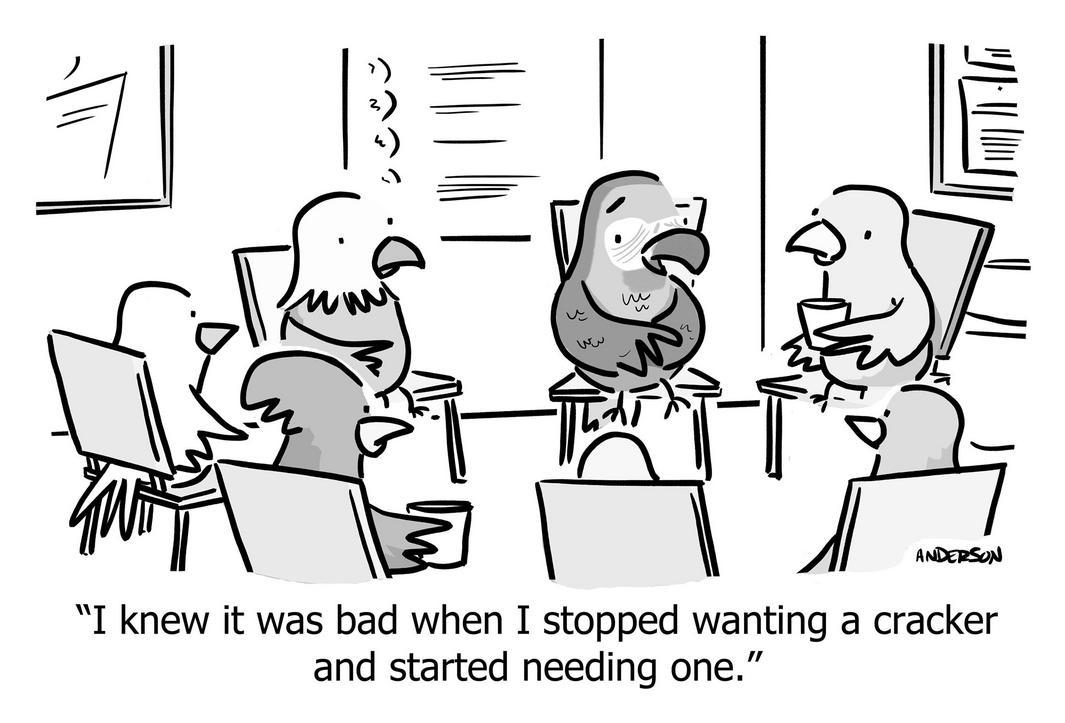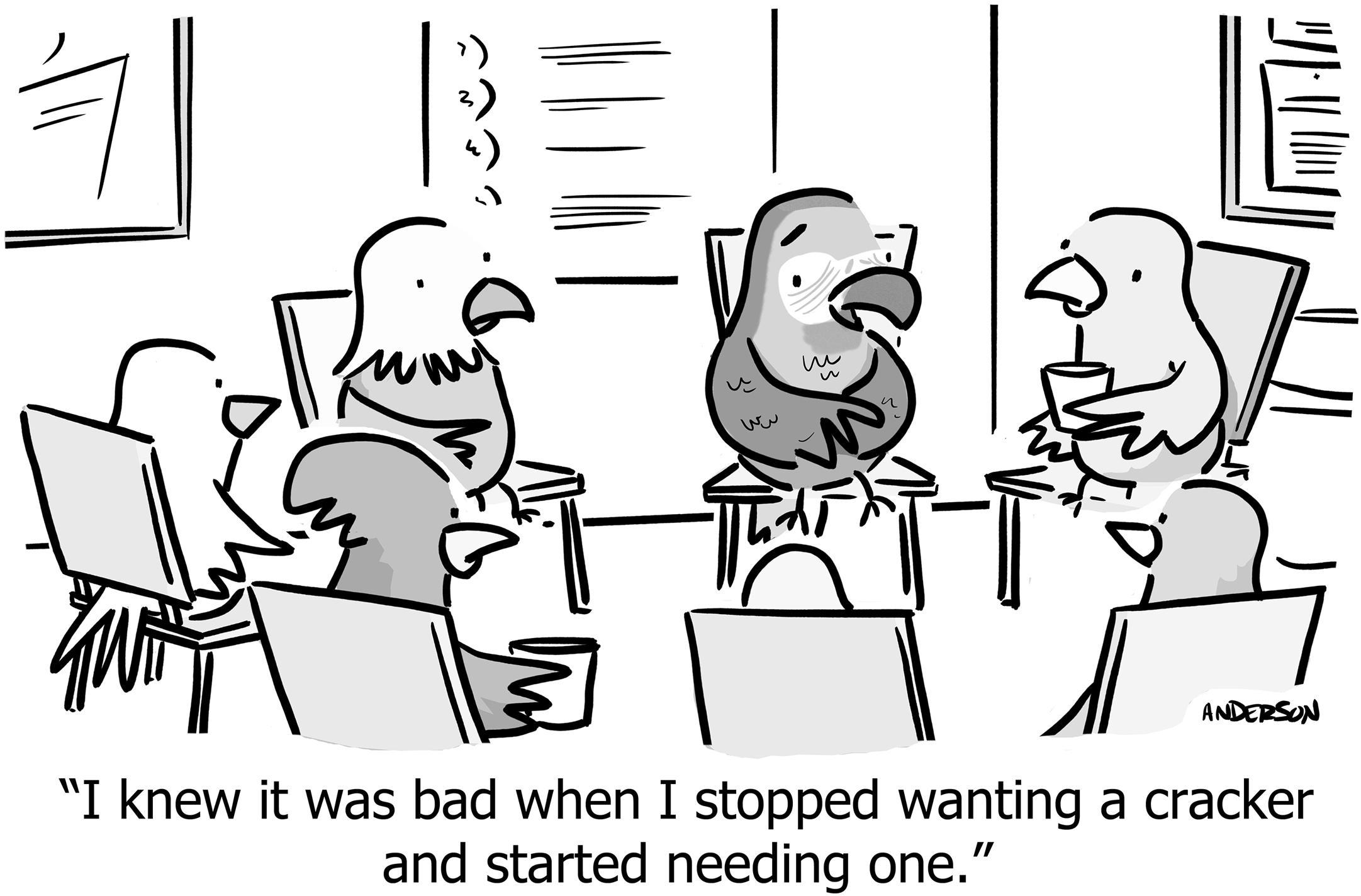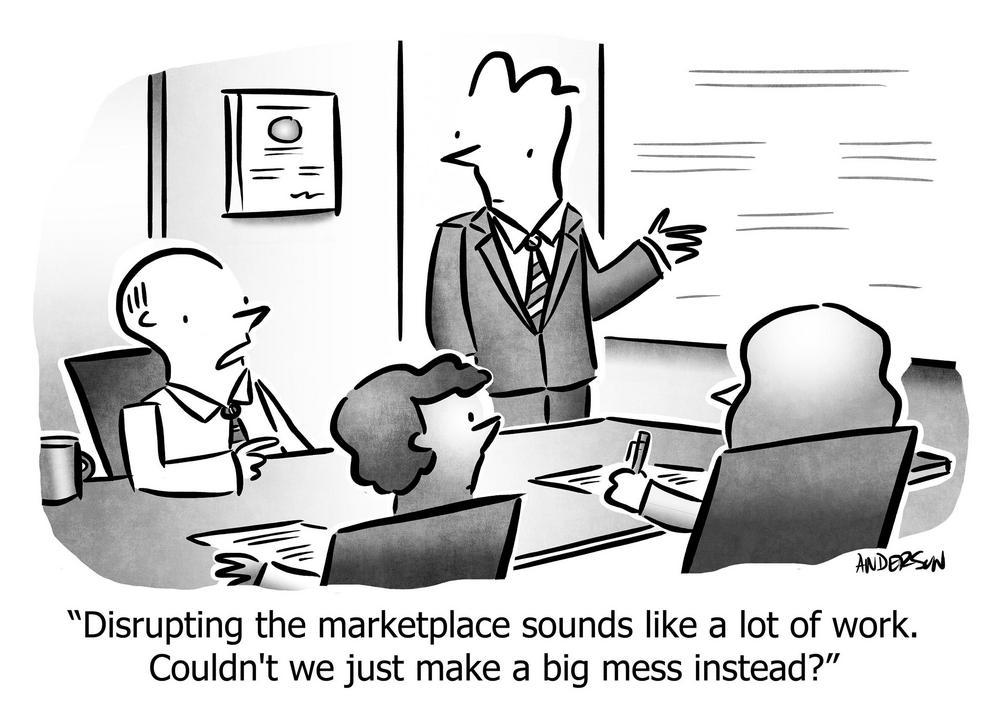Using the Needs Stack for competitive strategy
The Needs Stack
How would you describe what is Charlie doing?
Charlie creates an account with AWS—Amazon Web Services: pay by-the-hour and by-the-gigabyte for internet servers, storage, and network connectivity—happy to see a “free tier” for the infrastructure they need, just like the “how-to” article explained. All the acronyms are new and unfamiliar; this is tricky, but exciting! Someday, Charlie’s website might grow large enough to exceed the free tier—let’s hope!
Apparently, what Charlie is doing is:
★ Buy infrastructure: web server, disk space, networking, database.
Nominally this is true, but Charlie’s life ambition is not “to buy infrastructure.” In fact, it’s a means to and end. What Charlie really wants is to have a functioning WordPress-based website, because WordPress is by an order of magnitude the most popular1 way for people to easily write and publish content, and integrate with online marketing software needed to build a successful website.
1 43% of the largest 10,000,000 websites use WordPress; Shopify is the next largest with 4%. (Data from W3Techs)
So, a better way to explain what’s happening, is that Charlie has a higher-level “need,” which is to set up a WordPress site. Getting the infrastructure is a means to an end, rather than the end itself; in this sense, it’s a “need” but it’s lower in the “stack.”
What Charlie is doing really is:
★ Set up a WordPress site.
→ Buy infrastructure: web server, disk space, networking, database.
This might sound like a verbose restatement of Jobs to be Done or Five Why’s, but there’s a strategic competitive insight lurking here, which companies often fail to appreciate, at their peril:
Charlie never wanted to set up infrastructure, and still doesn’t. Charlie wants a WordPress site. Therefore, a company who provides the higher-level need of “WordPress site” makes the lower-level need of “infrastructure” obsolete.
Specifically, when a company like WP Engine makes it possible to set up a WordPress site in one minute, with no infrastructure to think about, handling all the technology and 24/7 monitoring, and customer support that helps with WordPress, then that company is going to win Charlie’s business, and AWS will never see Charlie.
Charlie disappears from the cloud infrastructure market. This is the insight.
If you ask AWS who their competitors are, the answers are other cloud infrastructure suppliers like GCP (Google), Azure (Microsoft), and Digital Ocean. And they are correct, because the Charlies of the world who do buy infrastructure, will buy from one of those. But WP Engine is also a competitor of AWS when it comes to Charlie, not because WP Engine competes on infrastructure (which it doesn’t, and in fact WP Engine itself buys infrastructure from AWS, GCP, and Azure!), but because WP Engine targets a higher-level “need” in the stack.
But you can’t stop there. That’s the trouble—you always want to stop when you’ve reached the level you operate on, but there’s always another level.
Instagram’s real product isn’t photos; it’s likes.
—Alex Danco
It’s not Charlie’s life ambition to make a WordPress site; this is just a means to an end. What Charlie really wants is to have a personal website for content and self-promotion. Charlie wants to carve out a digital pied à terre. In the virtual universe there’s infinite terre, so why not slap your pied on some of it!
Now the Needs Stack becomes:
★ Have a personal website for content and self-promotion.
→ Set up a WordPress site.
→ Buy infrastructure: web server, disk space, networking, database.
Charlie can still achieve this higher-level need with WordPress running on WP Engine—indeed, over one million websites run this way today. But there are alternatives that target this higher-level need. Wix and Squarespace both let you create websites without WordPress, cutting out the step of “get WordPress” just as WP Engine cut out the step of “get infrastructure.”
Does this mean WP Engine no longer has a business? No, that’s not the conclusion, any more than you should conclude that AWS no longer has a business. WP Engine is 15 years old and still healthy, growing, and profitable; AWS just posted $5.2B in profit just last quarter. So what’s going on?
These alternatives to WordPress certainly have advantages, but they are worse than WordPress for long-form content and for customizability. For this reason, they might not be right for Charlie. But they are competitors. Similarly, WP Engine doesn’t let you customize your infrastructure, so those who need to do so, still need to buy directly from AWS.
The pattern here is the next insight: Up the stack, customers achieve their end-goal faster; down the stack, customers have more flexibility and customization.
But wait… once again “having a personal website” is not Charlie’s life ambition, but rather just a means to an end. Charlie really wants a book deal. Being a properly-published author with a hard-back volume on the shelf that you can show to your kids (who will just shrug today but maybe someday they’ll appreciate it), and that you can gaze upon now and then in your dotage as a great accomplishment. This is Charlie’s personal idea of “successful and popular.” The way to get a book deal is to already have an online following; you’ll have honed your writing craft, you’ll have a natural audience to kick-start sales, and the fact that you’ve won followers in the competitive, noisy Internet proves your content is worth reading. Publishers want authors whose content has been de-risked and who come with a built-in marketing channel.
So the Needs Stack deepens:
★ Become a popular content-producer, leading to a book deal.
→ Have a personal website for content and self-promotion.
→ Set up a WordPress site.
→ Buy infrastructure: web server, disk space, networking, database.
The new layer brings new alternative solutions. There are companies like Substack, purpose-built to help you gain a following, with the tools for long-form content, for building a mailing list, and for promoting your content on social media.
Substack doesn’t automatically win, because WordPress is better than Substack in many ways. For example, WordPress is far more configurable, so you can make it look unique, unlike a million newsletters at Substack that all look identical (with character-kerning that’s too wide for my taste, but I’m biased). Also, the tools for long-form writing in WordPress are far superior, with drag-and-drop elements supporting complex layouts—including different layouts for phones versus tablets versus laptops—that an email newsletter cannot support. If Charlie values those things, then WordPress is still the right choice.
This again exemplifies the pattern that software at higher levels of the Needs Stack have fewer features and less customization than software lower on the Stack. In exchange for these limitations, their focus on the higher-level Need means it’s easier for the customer to achieve that Need. If the ease of achieving the Need is more important to a customer than the ability to customize and extend, the higher-level product makes all lower levels obsolete.
But wait a minute Substack because—you guessed it—there’s another level to Charlie’s Needs Stack. Because while Charlie wants a book deal as a signifier of popularity and success, it’s not Charlie’s life ambition. Charlie really wants to become a famous speaker. It started at a Tony Robbins show; Charlie instantly knew that the stage was their calling. It’s the prestige of being “that person” at parties, and the idea of being a jet-setter in first-class and a black car to pick you up with your name in the window, the ego basking in the glow of the lights and the elevation of the stage, gazed upon by an adoring audience who rushes up afterwards to grab a selfie and nervously blurt out a fraction of a story about how the speaker changed their life.
And the money.
★ Get lucrative speaking gigs around the world.
→ Become a popular content-producer, leading to a book deal.
→ Have a personal website for content and self-promotion.
→ Set up a WordPress site.
→ Buy infrastructure: web server, disk space, networking, database.
Charlie’s plan isn’t bad, but what if it were possible to skip the website and years of writing and self-promotion and the book deal and the two years of labor creating the book and directly become the next Tony Robbins? It’s not impossible; there are speaker bureaus and online services like SpeakerMatch that help you find gigs and facilitate the transaction. Why spend years building an online following (if you’re lucky) when you could spend that time creating inspirational presentations, delivering them to acclaim, earning testimonials for your next gig, building a reputation with an agency, and getting bigger and better gigs over time. In this scenario, Substack, Squarespace, WP Engine, and AWS are all irrelevant for Charlie; with the higher need met, the rest might as well not exist.
The moral of the story is: You need to understand the Needs Stack of your target customers. Not just your “market” or your “product” or “solving the problem” or even the immediate Jobs-To-Be-Done of your customer—those are all means to ends.
Already you can see how this will help you think about positioning and features; let’s see what else it helps you to do.
How to leverage the Needs Stack
The solution to “selling benefits” vs “selling features”
“Sell benefits, not features” marketers have told us since the universe cooled enough for galaxies to form. We’re supposed to say “saves time” rather than showing a screenshot of the feature. (Or better yet, “grows revenue.”) For Charlie, say “Become famous” rather than “Get a website.”
And yet, does an Engineer looking for a database infrastructure solution really want to be told “saves time” or do they want to see specs and features? (A: Specs and features.)
If a construction worker is looking for a wrench, do they search Google for “wrench that saves me time” or “socket wrench for a 5/16” lock nut?” And when that person clicks a link to potentially buy the wrench, do they want pictures of happy people “saving time,” or do they want to see the specifications and features like “has a mounted light.” Do they really need to be told “the light is useful to see in dark corners?” Oh! Thanks for spelling out the benefits of photons!
So which is it?
The Needs Stack suggests an answer. Charlie is not constantly and consciously thinking “I gotta become Tony Robbins,” even though that’s the top of their Needs Stack. Charlie is thinking at some other level of the stack at any given moment, for example “I gotta get some content online.”
Google searches are a good proxy for “what level of the stack are potential customers operating at right now?” When Charlie embarked on this project, the search might have been something like “best way to publish online,” not “how to become a famous globe-trotting speaker.” After reading some articles about how WordPress is inexpensive, popular and has all the tools you need, maybe then Charlie moved down the Stack to search “how to get a WordPress site.”
If someone has in their head “get a WordPress site,” you want to meet them where they are, and talk about how your product is the best way to “get a WordPress site.” That’s the part where you talk about features.
However, benefits still have a role to play, because it’s true that these features are a “means to an end,” and the more you convince the customer that you’re the best means to that end, you win even over alternatives. So, you can sell the benefits that are one level higher on the stack.
In this case, you could imagine a home page message like: “Become famous online with our turn-key, customizable WordPress website.” That’s the benefit from one level above, promised as a consequence of the current level.
Conversely, if you’re Substack, you can’t say “customizable” because that’s not what the product is, and it’s barely even a “website” (it’s just back-issues of your newsletter), but you can speak to the product “getting eyeballs.” So, that message could be “Grow your own audience with our turn-key newsletter platform.”2
2 Sure enough, as of this writing the Substack homepage says: “Substack lets independent writers and podcasters publish directly to their audience and get paid through subscriptions,” which are benefits from one level higher (i.e. “be independent” and “get paid for writing”). Lower on the page it lists features from the level they are on: “A Substack combines a blog, newsletter, payment system, and customer support team—all integrated seamlessly with a simple interface. We handle the admin, billing, and tech.”
Position lower levels as irrelevant
If Substack tried to fight the battle at the “get a website” level of the stack, they would lose every time—it has almost no features of a modern website. But, it can fight the battle at the “build an audience” level; for some subset of the market, that’s a more relevant level. Therefore, the idea is to make all levels below that irrelevant, by focusing only on your benefits:
“While others just give you a website, we help you build a following.” Right, because “popularity” is what I wanted, not “a website!” This message won’t work on businesses, for example, because they actually do need a website. But for the aspirational speaker, this might be perfect.
Conversely, WP Engine does the same thing with cloud services. The major cloud services say: “Oh it’s easy to have a WordPress site. You just click 17 times on all this stuff to make a server, and then download and install a bunch of stuff to create server software, then set up and configure WordPress, then use this 8-page tutorial to integrate with a fast caching network (which costs extra), then download and configure WordPress plugins to talk to the caching network, then stay on top of all the security patches and software upgrades, and it wouldn’t hurt you to learn how to SSH into your Ubuntu server so that….”
Whereas, the Managed WordPress Platform says: “You don’t want infrastructure, you want a WordPress site, and in less than one minute, you’ll have exactly that. And it’s faster and more secure than doing it yourself. And when you have trouble, you can call our support line, which cloud services don’t have.”
In short, make “infrastructure” irrelevant by focusing on the next level up. The customer never wanted to think about infrastructure in the first place.
Add more value by moving up the hierarchy
If products targeted at one level disrupt the products below them, there’s an obvious strategic conclusion: You could disrupt yourself and your competitors by moving up the hierarchy.
There are huge barriers to accomplishing this. The barriers are so large, companies almost never overcome them:
- The next level is a different product, and a different business.
- If you’re known for selling WordPress sites, you’d have to re-brand to be known for building an audience, whether that’s actually a new brand or expanding an existing brand. You also need to become expert in what that product is, and build it.3 You might need to change your business model, e.g. selling infrastructure by the gigabyte, versus selling whole websites by the month, versus selling new subscribers on a pay-for-performance basis, versus taking a percentage of speaking fees.
- The next level isn’t possible
- It’s not clear that one can build a product that fulfills the promise to get someone a substantial following. Twitter and Facebook sort of can, in that you can pay them to advertise your content. But the Internet is a large and noisy place; marketing software doesn’t automatically generate attention. Once you get the attention, if your content isn’t compelling, software can’t force people to subscribe. In short, if you go high enough in the Needs Stack, you might run into something that a product cannot produce. (Or at least you can’t.)
- The next level targets a smaller market
- Few people share Charlie’s Needs Stack exactly. A business with a broad customer base like WP Engine sells an all-purpose platform for all kinds of sites. There are many different personas whose Needs Stack includes “set up a WordPress site.”4 In each case, the “next level up” is different. Therefore, targeting a higher level also means narrowing the market. This might be wise—it is a tried-and-true strategy to be the best product in a smaller niche, rather than a small fish in a large, crowded ocean. But, a company who has an established brand in the wider market might not want to narrow into a sub-market. There might not be enough money in it.
3 Or buy it, which mature companies often do, trading cash for speed-to-market.
4 e.g. individuals wanting attention, companies broadcasting their brand, media companies attracting eyeballs for advertising revenue, eCommerce stores using content-marketing to drive sales, communities using content to inform and engage, non-profits raising money, governments interacting with citizens
Since a full pivot is unlikely to succeed, there are other ways to build a strategy that partially climbs the hierarchy:
- Create sub-brands / products
- Keep the original business going, and launch “vertical” or “niche” products. Leverage the scale and operational excellence of the parent, but treat each product as its own “startup.”
- Add features without fully committing to the next level
- Perhaps you can’t completely pivot to a product that promises subscriber-growth, but you could create an add-on product that helps someone do that. This becomes an extension of an existing product, aimed at personas who share that next level of their Needs Stack.
- Better marketing
- Address the need with words instead of features. Without “promising” results, you can help, educate, and lead in that area. You can have a field guide about how to attract and retain subscribers to a blog. You can give customers ideas for new kinds of content. You could partner with other companies who help with promotion. You could highlight customers who have been successful, wherein they share their experience to help others.
Still, while this advice is good for most organizations who cannot completely move up the hierarchy, there are examples of fantastic businesses that succeeded exactly because they successfully made the transition. For example, all of the case studies given in the “Emotional vs Functional” chapter of Blue Ocean Strategy, such as Cemex selling “build an addition to your house, for your family” instead of just selling cement or Starbucks selling a lifestyle experience rather than B-grade coffee.
Measure the next level up
The perennial question: Which few key metrics measure whether the customer is deriving value from our product, and thus predict whether they’ll stay a customer? And beyond that, become a vocal advocate? The Needs Stack helps us uncover these more strategic metrics.
Metrics from the bottom of the Stack measure whether we’re operating well, and certainly this is necessary even if not sufficient. Metrics at the level the customer is actively thinking about are useful to measure whether our Product is delivering on its direct promise, which again is vital.
It’s strategic to measure further up the stack. Not too far, otherwise it’s not only difficult to measure, but too many external factors drive the number. But the very next level up could be a critical way to measure value and to understand whether customers will be happy in the long run.
If a customer of Shopify successfully creates a store, the product of “have a store online” is succeeding, and that will be reflected in metrics like “number of products currently for sale” and in user surveys like “how easy was it to set up products for sale.” That’s important, but what if no one buys their wares? That customer will probably churn, even though the software delivered on its promise. Indeed, Shopify has enormous cancellation rates that would sink most companies; they survive because the ones that stay, grow a lot. Because they have so many inbound new customers, they can manage around the fact that only 34% stick around for even one year.
Can Shopify ensure that all customers who create a store end up doing thousands of dollars a month in business? No, this is an example where the next level up is vital, but Shopify cannot control it. However, they can measure it, and help. They could have articles about how to do online marketing, or features inside the store that help potential customers complete a checkout rather than abandon.5
5 Features like ShopPay, in which previous customers of other Shopify stores are fast-tracked through the purchase process, increasing the percentage of shopping carts that result in completed transactions.
This is why Shopify’s primary success metric is GMV;6 they report it to Wall Street directly after revenue, and in the same large font. GMV measures whether their customers are succeeding in the next level up on the stack. GMV not only reflects the truth about where the customer value is, it also encourages their product mangers to think about how to stretch up from the level of the stack they fully control.
6 Gross Merchandise Value: the total amount of money their customers are selling through their stores.
A source of higher purpose
Our direct goals are often simple: Sign up more customers, get them to activate on the product, reduce churn, reduce support tickets, reduce costs. All of that is important, but none of it creates a higher purpose.
What’s it all for? Why should we even bother?
Many companies can’t answer the question. Indeed, maybe they have no purpose other than “growth.” Will folks be motivated to do their best work at a company that values only conversion rates?
Purpose can be found in the higher levels of the Needs Stack. The immediate work is “getting a website,” but the higher purpose is to enable someone to build a career for themselves, to engage their creativity and speciality, to help them win the respect of others. Or help them become a hero within a bigger organization through some new marketing project, which will eventually lead to their promotion. Or help them raise awareness and money for an important cause. Or enable them to speak truth to power in a region of the world where such speech is forbidden.
Tell those stories. On the website and internally. Celebrate with your team when this actually happens for a customer, because that is what it’s all about. Those stories are why we should care.
Identify those upper reaches of the Needs Stack, not only because it helps you build more valuable features, not only because it helps you build a better strategy, but because it is the ultimate reason why any of this is worth doing in the first place.
https://longform.asmartbear.com/needs-stack/
© 2007-2025 Jason Cohen
 @asmartbear
@asmartbear Simple eReader (Kindle)
Simple eReader (Kindle)
 Rich eReader (Apple)
Rich eReader (Apple)
 Printable PDF
Printable PDF










